| |
Pris: 1055 SEK exkl. moms  |  This innovative study, by emphasizing the agency relations and the property law claims embedded in the use of such unconventional instruments, analyses and discusses the governance regulation of hybrids in a way that is primarily functional, departing from more common approaches that focus on tax advantages and internal corporate control. The author assesses the role of hybrid instruments in the modern company, unveiling the costs and benefits of issuing these securities, recognizing and categorizing the different problem fields in which hybrids play an important role, and identifying legal and contracting solutions to governance and finance problems. The full-scale analysis compares the U.K. law dealing with hybrid instruments with the corresponding law of the most relevant U.S. jurisdictions in relation to company law. The following issues, among many others, are raised: This innovative study, by emphasizing the agency relations and the property law claims embedded in the use of such unconventional instruments, analyses and discusses the governance regulation of hybrids in a way that is primarily functional, departing from more common approaches that focus on tax advantages and internal corporate control. The author assesses the role of hybrid instruments in the modern company, unveiling the costs and benefits of issuing these securities, recognizing and categorizing the different problem fields in which hybrids play an important role, and identifying legal and contracting solutions to governance and finance problems. The full-scale analysis compares the U.K. law dealing with hybrid instruments with the corresponding law of the most relevant U.S. jurisdictions in relation to company law. The following issues, among many others, are raised:
-decisions under uncertainty when the risks of opportunism of the parties is very high;
-contract incompleteness and ex post conflicts;
-protection of convertible bondholders in mergers and acquisitions and in assets disposal;
-use of convertible bonds to reorganise and restructure a firm;
-timing of the conversion and the issuer’s call option;
-majority-minority conflict in venture capital financing;
-duty of loyalty;
-fiduciary duties to preference shareholders; and
-financial contract design for controlling the board’s power in exit events.
Throughout, the analysis includes discussion, comparison, and evaluation of statutory provisions, existing legal standards, and strategies for protection. It is unlikely that a more thorough or informative account exists of the complex regulatory problems created by hybrid financial instruments and of the different ways in which regulatory regimes have responded to the problems they raise. Because business parties in these jurisdictions have a lot of scope and a strong incentive to contract for their rights, this book will also be of uncommon practical value to corporate counsel and financial regulators as well as to interested academics.
Content:
Introduction. Part I: Regulatory Issues of Hybrid Financial Instruments: The Classification Approach. 1. A Historical Perspective. 2. Distinguishing between Equity and Debt. 3. Setting the Theoretical Background. Part II: Governance Regulation of Hybrid Financial Instruments: The Functional Approach. 4. From the Classification to the Functional Approach. 5. Significant Corporate Decisions. 6. Financing through Hybrid Instruments: Risks of Opportunism and Legal Strategies for Mitigation. 7. Control Transactions. 8. Conclusive Considerations. Bibliography. Table of Cases. Table of Legislation. Index.
| | |
|